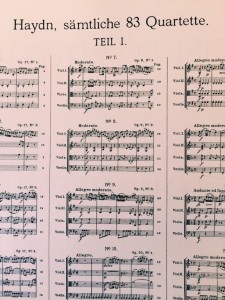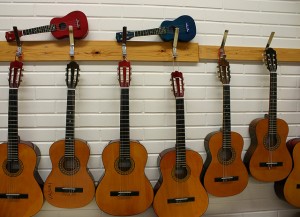Photo CC licensed http://bit.ly/1s7HCnP
Where on earth do we start?
It’s funny, if the topic was reading material, then there are clear categories, criteria, and you could go so far as to say strategies for how to approach and structure your reading. It does help that English and literature are core parts of the school curriculum. Actually the way we approach literature is great, and I wish that this was also the way for music. For example, it would be safe to say that most people have experience with libraries, and from a very young age we are taken to libraries to check out books, listen to stories, and just have a look around. Do we do the same with music? School children go to libraries to delve into exploring the different types of book on offer. Do we approach musical repertoire in the same way?
It is made more difficult by having so many different instruments- so in effect although there is a common musical language, there are so many dialects (as pieces written for different instruments) that as a cellist, I could hardly ‘browse’ the music for trumpet. Beside the fact that trumpet transposes, the writing is likely to be idiomatically specific for that instrument (depending on the composer of course), and many people can’t ‘hear’ the music from reading the score alone.
So really, where do we begin??
There do exist lists of repertoire. Much like a card catalogue, you can find swathes of beginner repertoire or lists of some of the ‘staples’ of the repertoire as seen on audition lists. Universities often require auditions and sometimes repertoire lists are presented to candidates. This happens across instruments and styles. Here are just a few examples of audition lists from universities in America: Eastman School of Music, Northwestern University, UCLA These can be useful, but they still do not provide the stepwise progression sort of list that people may want when planning a curriculum.
In England there are various examination boards with published repertoire lists for different graduated levels, and these are useful, but neither exhaustive nor prescriptive.
- Associated Board of the Royal Schools of Music
- Trinity College London
- Rockschool
- London College of Music
In Canada there is the examination board the Royal Conservatory of Music, who publish complete repertoire lists throughout all of their grades. The piano list can be found in this 2015 booklet.
The Susuki method also has progressive books that ‘level up’ as they go. Many schools and systems of learning do have some organisation of repertoire, but none claims to be comprehensive or all inclusive.
Perhaps you haven’t thought about the giant sea of repertoire out there? All you have to do is search by instrument on the IMSLP and you will begin to realise how many different works there are out…
Task: Write it down
Before you do a big search and discover the endless list of works for your instrument and arrangements that are possible to perform, make a post about:
- WHAT REPERTOIRE YOU KNOW and
- HOW YOU KNOW IT
Start like you are writing a musical CV of the main works you have learned or performed. You can either do the whole lot, or narrow it down to a year of learning… Reflect on what you learned and how the list came about. Were you involved in steering or choosing the repertoire?
What do you know?
“…I know the music I learned from my teacher.”
Photo CC licensed: http://bit.ly/1vLs9dj
Finding new material
To sift through the millions of compositions we need a few guidelines. Criteria. Questions. They don’t need to be complex, and you can add as many as you like. Here are two questions for starters:
1. What are you looking for? (style, genre, instrumentation, short or long…)
2. Can you tell what it takes to realise/play that music? (technical/musical requirements)
That first question is simply to hone the search, because there are hundreds of thousands of works that you could sift through without narrowing down the search a bit. The second question is more specific. If we go back to the book analogy, there is often a short blurb on the jacket cover of a book, and if it is a children’s/young adult book, it will say so. In fact it will give you an approximate reading level. So before you had to open the book, you knew roughly how long the book is (by just looking at its size), the subject, a bit about the style and content, and the approximate reading level. Wouldn’t it be fantastic if musical literature was also like that?!
It does happen in rare instances – I have an old copy of the Haydn String Quartets where inside the front cover there is a few bars of each of the four parts, to show the tune and to identify which quartet it is.
That is genuinely helpful, certainly the cello part alone (my part) doesn’t necessarily hold the identifying features for each quartet. However, this is not common practice. …but it is useful… so as a task:
Task: Make a ‘book jacket’ for music
Find three pieces of music that you might include in your repertoire list and make a jacket cover with just that sort of useful information: the main tune, the range, the difficult techniques…. it is up to you exactly what you include, but it should be an at-a-glance type reference that you or another performer could usefully look at for that piece.
Photo CC licensed: http://bit.ly/Zt5dEd
How can you find out what else is out there?
Students traditionally look to their teachers for direction and for what comes next in their learning. Teachers can create settings that encourage students to go out and continue to grow and awakening as they feed themselves new musical experiences.
Read. See. Listen. Talk. Connect.
it ain’t going to play itself…
There will be compilations of works, whether these are books of modern, purposely-commissioned works as in the Spectrum series or traditional books like the 24 Italian Songs and Arias for Soprano or the jazz tome The Real Book. It is important for you to actively find out what is out there and to make informed decisions about where and how it fits into your (or your student’s) learning.
Search the interwebs. The Musician’s Way blog has some good posts about learning music. Overall repertoire, how to find it, and the best progression is something that is highly individual and people are left either to their teacher’s guidance, to chance, or to somehow discover things for themselves.
Photo CC licensed: http://bit.ly/1qimR3w
Take the first steps. Go to concerts. Challenge yourself to keep learning more.
Task: Find some music
Over the next week find 3 new pieces of music. Listen to them, see them performed if possible, read the score if there is one. Write about the experience. What is it like to experience new music? Is it old new music? What did you learn and would you consider adding these to your list of repertoire?
Photo CC licensed: http://bit.ly/1vQ4CqN
Taks: Grow your list.
Ok. What you know, what’s out there, now where do you want to go with it? Challenge yourself to look forward, whether it is for you or the student you are planning for…
Be brave and post about these things. Musicians tend to learn in private and the idea of discussion and sharing is not necessarily second nature to everyone. Remember that these tasks are planned in the spirit of collaboration and of building a community and of growing our knowledge, cumulatively and individually.
You can post on Twitter or on your own site and tweet a link tagging it #MUS654



Pingback: It's all about Repertoire - lauraritchie.com
Hello! Am reallyy enjoying following this course as it progresses, even if I did finish uni 6 years ago.
Am moving house shortly and I’m really looking forward to trying the ‘create a book jacket for a selection of pieces’ idea, ive got quite alot of sheet music to sift through so when I’m unpacking I will definitely give it a go 🙂
Thanks Laura